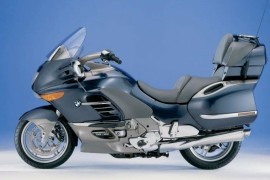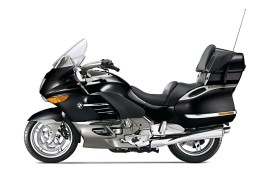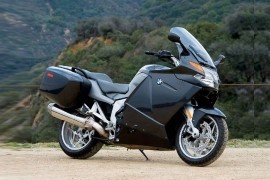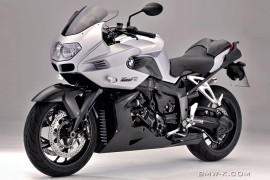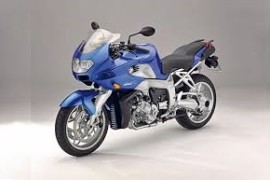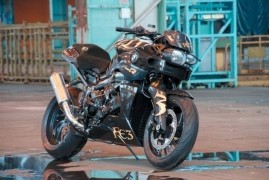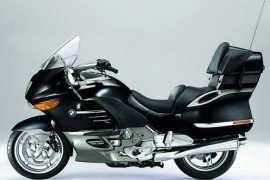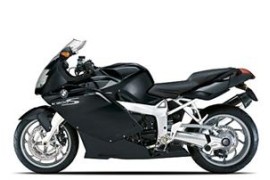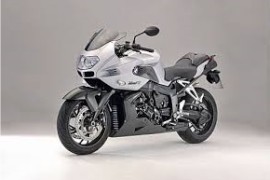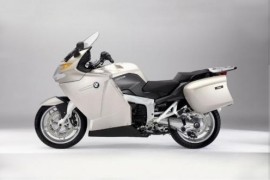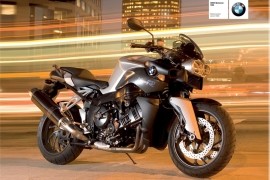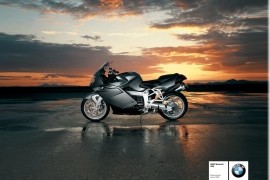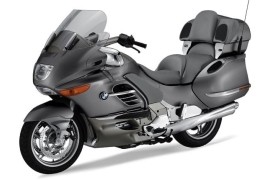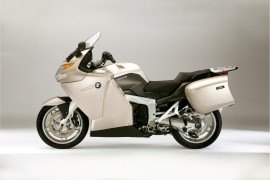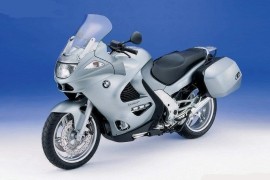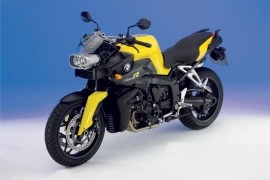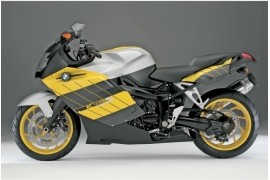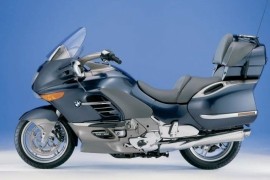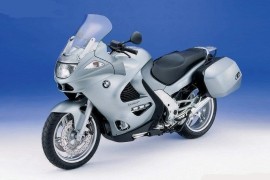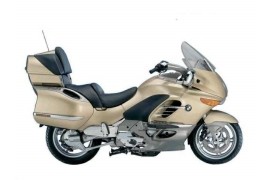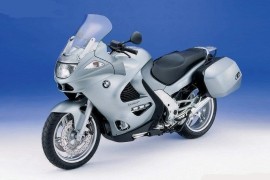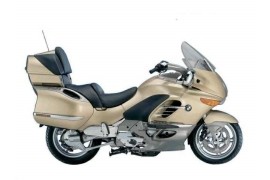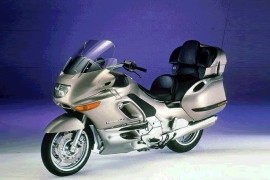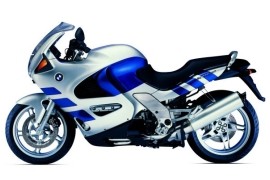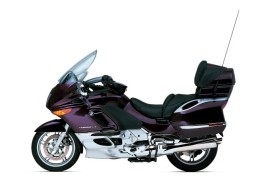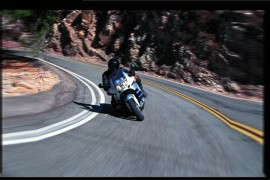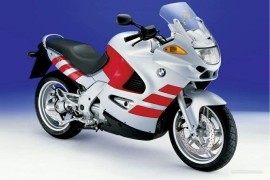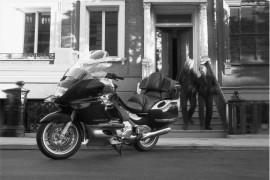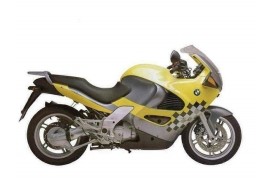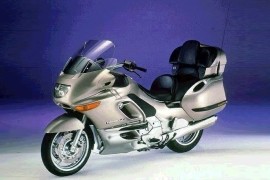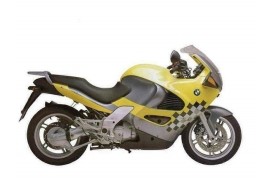BMW K 1200 Models/Series Timeline, Specifications & Photos
First production year: 1997
The BMW K1200LT was a touring motorcycle that debuted in 1998 as a replacement for the BMW K1100LT and a competitor to the Honda Gold Wing. Compared to other K models in BMW's range, the K1200LT was the most luxurious touring machine.
In 2009, the German motorcycle manufacturer launched the BMW K1200LT, the most comfort-oriented touring motorcycle available only for the American market. The bike delivered excellent performance and impressive comfortability due to its accessories and options.
In the aesthetic department, the BMW K1200LT packed standard features, such as a full fairing with an electrically adjustable windscreen, a pulled-back handlebar, a comfortable rider seat with lumbar support, a passenger seat with a backrest integrated into the top case, side-mounted, color-matched panniers, and lightweight aluminum wheels.
The bike was built on an aluminum/steel frame with the renowned Telelever front and Paralever rear suspension system that offered a plush riding experience and excellent handling. The bike's wheels were fitted with two 305 mm discs with four-piston calipers on the front and a 265 mm disc with a dual-piston caliper on the rear, delivering strong stopping power.
Underneath its armor, the 2009 BMW K1200LT was equipped with a 1,172cc four-stroke liquid-cooled four-cylinder engine with a fuel injection system in charge, delivering 116 Hp with maximum strength at 8,000 rpm and 117 Nm (86 lb-ft) torque at 5,250 rpm.
In 2008, the German motorcycle manufacturer launched the BMW K1200LT, a luxury touring motorcycle that debuted in 1998. The bike was released as a replacement for the K1100LT and a competitor to the Honda Gold Wing.
In 2008, the BMW K1200LT received a boost, with every UK machine featuring the full BMW Lux package as standard. Also, in 2008, the standard and SE versions of the K1200LT were removed from the UK range, remaining only the highest-specification motorcycle.
The Lux package had an MSRP of $15,400 and included any extra accessories available for the range, including heated grips, cruise control, a heated seat, central locking for the top case and panniers, an anti-theft system, and ground lighting.
In addition to all options and accessories, the BMW K1200LT was also available with several tweaks and tricks, such as a luggage rack, a taller windscreen, an intercom, a CD changer, and even a cup holder.
Underneath its clothes, the 2008 BMW K1200LT had installed a 1,172cc four-stroke four-cylinder liquid-cooled engine fed by an electronically controlled fuel injection system, delivering an output power of 116 hp with a peak force at 8,000 rpm and 117 Nm (86 lb-ft) torque at 5,250 rpm.
The bike's power was handled by a six-speed manual transmission with a dry single-plate hydraulically controlled clutch and a final shaft drive, pushing the motorcycle to a top speed of 198 kph (123 mph).
The BMW K1200GT was a sport-touring motorcycle that debuted in 2003 as a replacement to the BMW K1200GT and continued production until 2008, when it was replaced by the larger BMW K1300GT.
Over its production period, there were two generations of the K1200GT. The first generation was manufactured from 2003 to 2006, and the second one from 2006 to 2008. The models manufactured from 2006 were more powerful and lighter than the ones built from 2003 to 2006.
In 2008, the German motorcycle manufacturer launched the BMW K1200GT, a sport-touring motorcycle with excellent performance and touring capabilities. The bike offered great comfort with its low seating position and high-mounted handlebar.
In the appearance department, the motorcycle had standard features, such as a full fairing with a medium-sized windscreen, a two-piece dual seat with passenger grab rails, a small luggage rack, color-matched, side-mounted panniers, a single-sided swingarm, and lightweight aluminum wheels.
The 2008 BMW K1200GT packed underneath its fairing a 1,157cc four-stroke four-cylinder liquid-cooled engine with a fuel injection system in charge, delivering 152 hp at 9,500 rpm and 130 Nm (96 lb-ft) torque at 7,750 rpm.
The bike's engine was coupled to a six-speed manual transmission with a wet multi-plate clutch and a final shaft drive, spinning the rear wheel to a top speed of 249 kph (155 mph).
In 2008, the German motorcycle manufacturer launched the BMW K1200R, a supersport naked motorcycle that debuted in 2005. The bike was part of the K series in BMW's range, comprising several models with different engine displacements and appearances.
When it was first released, BMW Motorrad claimed it was the fastest naked motorcycle in the world, with acceleration from 0-100 kph (0-60 mph) in only 2.6 seconds. It was exceeded by the Suzuki B-King, which delivered more power, but the BMW K1200R still had faster acceleration and a higher top speed.
In the visual department, the bike had standard features, such as an odd-looking headlight, a minuscule windscreen, a one-piece dual seat with passenger grab rails, a single-sided swingarm, a four-into-one exhaust system, and lightweight aluminum wheels.
Underneath its fuel tank, the 2008 BMW K1200R had installed a 1,157cc four-stroke four-cylinder liquid-cooled engine managed by a fuel injection system, delivering 163 hp at 10,250 rpm and 127 Nm (94 lb-ft) torque at 8,250 rpm.
The bike's engine power was handled by a six-speed manual transmission with a hydraulically controlled wet multi-plate clutch and a final shaft drive, pushing the bike to a top speed of 262 kph (163 mph).
The machine packed a Telelever suspension system on the front and two 320 mm brake discs with four-piston calipers. The rear end was handled by a Paralever suspension system with a 265 mm brake disc, delivering excellent suspension performance and stopping power.
The BMW K1200R started its life back in 2005 as a naked supersport machine that continued production until 2008, when it was replaced by the larger BMW K1300R. The bike had impressive acceleration from 0-100 kph (0-60 mph) in only 2.6 seconds.
At its release, BMW Motorrad claimed that the BMW K1200R was the most powerful naked motorcycle in the world until Suzuki launched the B-King. Despite the higher output of the Suzuki B-King, the K1200R had faster acceleration and a higher top speed.
In 2008, the German motorcycle manufacturer launched the BMW K1200R, a powerful naked machine available with a wide range of accessories and optional features, such as the Electronic Suspension Adjustment system and Anti-Lock Braking System II (ABS II).
The bike was built on a lightweight aluminum frame with a Duolever suspension system on the front coupled to dual 320 mm floating discs with four-piston fixed calipers. In contrast, the rear end was handled by a Paralever suspension system paired with a 265 mm disc and a dual-piston floating caliper, delivering excellent handling capabilities and stopping power.
Underneath its fuel tank, the 2008 BMW K1200R Sport had installed a 1,157cc four-stroke four-cylinder liquid-cooled engine fed by a fuel injection system, delivering 163 hp at 10,250 rpm and 127 Nm (94 lb-ft) torque at 8,250 rpm.
The BMW K1200R was a naked sports bike manufactured from 2005 to 2008 powered by a 1,157cc four-cylinder engine that delivered great acceleration from 0-100 kph (0-60 mph) in only 2.6 seconds.
The maker claimed it was the most powerful naked motorcycle in the world until Suzuki launched the B-King. Although the B-King had more power, the K1200R had better acceleration and a higher top speed.
In 2007, the German motorcycle manufacturer launched the BMW K1200R Resident Evil 3, a special edition machine created for the Munich screening of the Resident Evil 3, Extinction movie.
The bike had airbrushed spinal bones on the fuel tank and gold lettering on the fairings made by talented artist George Huber, which set the bike apart from all other BMW K1200R models. In addition, the bike had a blacked-out look that further enhanced the menacing look of the powerful streetfighter.
In other departments, the special edition machine was identical to the standard K1200R, packing the same performance, technical, and visual specifications.
Underneath its fuel tank, the 2007 BMW K1200R Resident Evil 3 had installed a 1,157cc four-stroke four-cylinder liquid-cooled engine managed by a fuel injection system, delivering 161 hp with maximum strength at 10,250 rpm and 127 Nm (94 lb-ft) torque at 8,250 rpm.
The bike's power was handled by a six-speed manual transmission with a final shaft drive, pushing the motorcycle to a top speed of 262 kph (163 mph).
The BMW K1200LT was a touring motorcycle that debuted in 1998 as a replacement for the K1100LT. The bike was part of the super tourer category and was intended to compete with the Honda Gold Wing and other machines in the same class.
In 2004, BMW presented a revised model with a more powerful engine, an electro-hydraulically extendable main stand, a new spring on the rear suspension, and a new Xenon light.
In 2007, the German motorcycle manufacturer launched the BMW K1200LT, the most touring-oriented machine that any other motorcycle in the K range. The bike also shared its engine and chassis with the BMW K1200GT.
The 2007 machine packed standard features, such as heated grips, Full Integral ABS, Cruise Control, an audio sound system, adjustable ventilation, adjustable clutch and brake levers, adjustable seat, adjustable windscreen, xenon light, and heated seats for both rider and passenger.
Underneath its full armor, the 2007 BMW K1200LT had installed a 1,172cc four-stroke four-cylinder liquid-cooled engine with a fuel injection system in charge of feeding the pistons, boasting 116 hp with a peak force at 8,000 rpm and 117 Nm (86 lb-ft) torque at 5,250 rpm.
The bike packed the renowned Telelever front and Paralever rear suspension system for suspension, delivering a plush riding experience and excellent handling. As for braking power, two 320 mm brake discs on the front and a 265 mm brake disc on the rear offered strong stopping power.
The 2008 MY BMW K 1200 S boasts an impressive 2.8 seconds to get from 0 to 60 mph, meaning it can compete with almost any production superbike out there. At its heart lies a powerful, liquid-cooled, four-stroke, 1157cc, in-line four cylinder powerhouse mated to a six-speed manual transmission, that produces 167 horsepower and 130 Nm of torque. The acclaimed Duolever/Paralever front/rear suspension package make for a plush ride, as well as superior cornering abilities, as well as the high-end BMW EVO braking system, which helps keep in check the massive power output of this two-wheeler.
Available optionals such as the ABS II and the Electronic Suspension Adjustment package can take this two-wheeler to the next level in terms of performance, and only add to the desirability of this impressive motorcycle among Beemer fans.
The BMW K1200R was a naked sports motorcycle manufactured by BMW from 2005 to 2008. At its launch, the manufacturer claimed it was the world's most powerful naked machine, accelerating from 0-100 kph (0-60 mph) in only 2.6 seconds.
In 2007, the German motorcycle maker launched a new version under the BMW K1200R Sport designation. The 2007 motorcycle was identical to the previous model, except for adding a small fairing and other minor tweaks and tricks.
In the aesthetic department, the 2007 BMW K1200R Sport packed a new fairing with a small windscreen, a one-piece dual seat with passenger grab rails, a four-into-one exhaust system with a single muffler mounted on the right side, and lightweight aluminum wheels.
Underneath its fuel tank, the bike had installed a 1,157cc four-stroke four-cylinder liquid-cooled engine managed by a fuel injection system, delivering 163 hp with a peak force at 10,250 rpm and 127 Nm (94 lb-ft) torque at 8,250 rpm.
The power produced by the engine was handled by a six-speed manual transmission with a hydraulically controlled wet multi-plate clutch and a final shaft drive. The bike reached a top speed of 260 kph (162 mph).
The 2007 BMW K1200R Sport was built on a lightweight aluminum frame with a Duolever suspension system, two 305 mm brake discs on the front, and a Paralever suspension system with a 265 mm brake disc, delivering excellent suspension performance and stopping power.
In 2007, the German motorcycle manufacturer launched the BMW K1200GT, a sport-touring motorcycle in its second generation. From 2003 to 2006, the BMW K1200GT was in the first generation, while from 2006, the maker restyled the machine for the second generation.
The 2007 BMW K1200GT packed the same engine as the BMW K1200S, a sports bike that held the world speed record in 2005, hitting 279 kph (174 mph). Compared to the models manufactured from 2003 to 2006, the 2007 model delivered more power and had a lower weight.
The machine had standard features, such as a full fairing with an electrically adjustable windscreen, adjustable clutch, and brake levers to accommodate a wide variety of riders, a two-piece dual seat with passenger grab rails, a small luggage rack, and side-mounted, color-matched panniers for increased touring capabilities.
Underneath its fairing, the BMW K1200GT had installed a 1,157cc four-stroke four-cylinder liquid-cooled engine with an Electronic Fuel Injection (EFI) system feeding the pistons, boasting 152 hp at 9,500 rpm and 130 Nm (96 lb-ft) torque at 7,750 rpm.
The engine was coupled to a six-speed manual transmission with a hydraulically operated wet multi-disc clutch and a final shaft drive, pushing the motorcycle to 249 kph (155 mph).
The bike was built on a lightweight aluminum frame with a Duolever front and Paralever rear suspension system coupled to dual 305 mm brake discs on the front and a 265 mm brake disc on the rear, offering excellent suspension performance and stopping power.
The BMW K1200R was a naked sports motorcycle manufactured by BMW Motorrad from 2005 to 2008. The bike was part of the K series in BMW's range, comprised of numerous models with different engine displacements and appearances.
When it was first released in 2005, BMW claimed it was the most powerful naked motorcycle in the world until Suzuki launched the B-King. Although the B-King had more power, the K1200R had faster acceleration and a higher top speed.
In 2006, the German motorcycle manufacturer launched the BMW K1200R, a super sports machine in its second year of production, a powerful motorcycle that did 0-100 kph (0-60 mph) in only 2.6 seconds.
In the visual department, the naked machine packed standard features, such as an odd-looking headlight, a micro windscreen, a one-piece dual seat with passenger grab rails, a four-into-one exhaust system, and Y-shaped five-spoke lightweight wheels.
The bike was also available with many options and accessories, such as an Anti-theft warning system, heated grips, a low-profile seat, ABS brakes, a luggage rack, clear turn signals, and a cockpit fairing. As for accessories, it was available with a BMW Navigator II GPS moving-map system, a center stand, adjustable side cases, a soft top case, and a tank bag.
The 2006 BMW K1200R packed underneath its fuel tank a 1,157cc four-stroke four-cylinder liquid-cooled engine with a fuel injection system in charge, delivering 163 hp at 10,250 rpm and 127 Nm (94 lb-ft) torque at 8,250 rpm.
The 2007 MY BMW K1200S is one of the fastest production motorcycles ever to be designed by the House of Munich, with a claimed 2.8 seconds from 0 to 60 mph. At its heart lies a powerful, liquid-cooled, 1157 cc, in-line four cylinder powerhouse mated to a six-speed manual transmission, and can produce 167 horsepower and 130 Nm of torque.
It features the acclaimed Duolever front and Paralever rear suspension package, as well as high-end Evo brakes with ABS as standard, which make for one of the safest, as well as agile Beemers, sure to cause a mini heart attack with every flick of the throttle even to the more seasoned riders.
In 2006, the German motorcycle maker released the BMW K1200LT, a luxury touring motorcycle part of the K series in BMW's range that comprised several models with different engine displacements and appearances.
When it was first released in 1998, the motorcycle replaced the BMW K1100LT and was part of the super tourer category, placed as a competitor to the Honda Gold Wing, but also machines in the class.
In 2004, the maker presented a revised model that included modifications such as a more powerful engine, an electro-hydraulically extendable center stand, a new spring for the rear suspension, and an optional Xenon headlight. In 2006, the bike was released at an MSRP of $22,000.
Compared to its K1200GT sibling that was more performance-oriented, the K1200LT was made with comfort and touring capabilities in mind, packing a full fairing with a medium-sized windscreen, a comfortable rider seat with lumbar support, a passenger seat with an integrated backrest in the top case, a sound system, and color-matched, side-mounted panniers for extra storage.
Under the hood, the 2006 BMW K1200LT had installed a 1,172cc four-stroke four-cylinder liquid-cooled engine fed by an electronically-controlled fuel injection system, delivering 116 hp at 8,000 rpm and 117 Nm (86 lb-ft) torque at 5,250 rpm.
The bike's power was converted into motion by a five-speed manual transmission with a hydraulic dry single-plate clutch, a return, and an overdrive mode, spinning the rear wheel through a final shaft drive, pushing the machine to 198 kph (123 mph).
The BMW K1200GT was a sport-touring motorcycle that debuted in 2003 and continued production until 2006 under the first generation. In 2006, the second generation of the K1200GT was released, packing the same engine as the BMW K1200S sportbike.
In 2006, the German motorcycle manufacturer launched the BMW K1200GT, a sport touring machine in its second generation. The second-generation models were lighter and more powerful than those produced from 2003 to 2006.
Also, the 2006 BMW K1200GT was slightly changed in the aesthetic department, packing redesigned fairings, an electronic immobilizer, an adjustable handlebar, an adjustable seat, a two-piece dual seat, an adjustable windscreen, side-mounted panniers, a single-sided swingarm, and lightweight aluminum wheels.
Underneath its full fairing, the 2006 BMW K1200GT packed a 1,157cc four-stroke four-cylinder liquid-cooled engine fed by an electronically-controlled fuel injection system, boasting 152 hp at 9,500 rpm and 130 Nm (96 lb-ft) torque at 7,750 rpm.
The bike's power was handled by a six-speed manual transmission with a hydraulically operated wet multi-disc clutch and a final shaft drive, spinning the rear wheel to a top speed of 249 kph (155 mph).
The motorcycle was built on a lightweight aluminum frame with a Duolever suspension system and two 320 mm discs coupled to four-piston calipers on the front wheel. The rear end was handled by a Paralever suspension system and a 294 mm disc with a dual-piston caliper.
In 2005, the German motorcycle manufacturer launched the BMW K1200LT (Luxury Tourer), a touring motorcycle that debuted in 1998. The bike was part of the super tourer category and was intended to compete with the Honda Gold Wing and other motorcycles.
The 2005 BMW K1200LT featured a newly designed two-section headlight that increased light output by ten percent. The top unit was the high beam, and the lower one was the low beam with an integrated parking light.
The cockpit was redesigned entirely and included a new Info-Flat-Screen, designed to provide many information, such as total distance, coolant and air temperature, radio information, fuel level, gear selections, and on-board computer functions.
In the visual department, the bike packed standard features, such as a full fairing with a medium-sized windscreen, a dual seat with rider lumbar support, a passenger seat with an integrated backrest in the top case, side-mounted panniers, and lightweight aluminum wheels.
The bike's suspension system comprised a BMW Motorrad Telelever front and a BMW Motorrad Paralever rear shocks, offering a plush and comfortable riding experience and excellent handling.
As for the braking power, the motorcycle packed two 320 mm discs with four-piston calipers on the front and a 285 mm disc with a dual-piston caliper on the rear, delivering excellent stopping power.
Underneath its clothes, the 2005 BMW K1200LT had installed a 1,172cc four-stroke liquid-cooled four-cylinder engine with a fuel injection system in charge, delivering 98 hp at 6,750 rpm and 115 Nm (85 lb-ft) torque at 4,750 rpm.
The BMW K1200GT was a sport-touring motorcycle that debuted in 2003 and continued production until 2006. From 2003 to 2006, the bike was in its first generation, while from 2006, it was manufactured in the second generation.
In 2005, the German motorcycle manufacturer launched the BMW K1200GT, a powerful and comfortable sport-touring motorcycle fitted with 21st-century technology.
In the aesthetic department, the bike was fitted with standard features, such as a full fairing with a single headlight, a medium-sized windscreen, a one-piece dual seat with a passenger grab handle, a small luggage rack, a single-sided swingarm, and lightweight aluminum wheels.
The bike was built around a lightweight aluminum frame with a BMW Motorrad Telelever front and Paralever rear suspension system, offering a plush riding experience and excellent handling capabilities.
The bike's wheels were fitted with two 320 mm discs with four-piston calipers on the front and a 285 mm disc with a two-piston caliper on the rear, offering excellent stopping power.
Underneath its fairing, the 2005 BMW K1200GT had installed a 1,171cc four-stroke four-cylinder liquid-cooled engine with a fuel injection system in charge, boasting 129 hp at 8,750 rpm and 117 Nm (86 lb-ft) torque at 6,750 rpm.
The bike's engine worked in tandem with a six-speed manual transmission, a hydraulically-controlled dry single-disc clutch, and a final shaft drive, pushing the motorcycle to 243 kph (155 mph).
The BMW K1200R was a naked supersport machine manufactured by BMW from 2005 to 2008. The bike was powered by a 1,157cc four-cylinder engine that delivered excellent power and torque, reaching 0-100 kph (0-60 mph) in only 2.6 seconds.
At its launch, BMW claimed that the BMW K1200R was the world's most powerful naked machine until it was succeeded by the Suzuki B-King. Even though the B-King had more output power, the BMW K1200R had faster acceleration and a higher top speed.
In 2005, the German motorcycle manufacturer launched the BMW K1200R, an asphalt-wrinkling machine with the most comfortable riding position found on a superbike and stripped down to its bare essentials.
In the visual department, the bike packed standard features, such as an odd-looking headlight, a micro windscreen, a one-piece dual seat with passenger grab handles, a four-into-one exhaust system with a muffler mounted on the right side, and lightweight aluminum wheels.
In the performance department, the 2005 BMW K1200R had its soul brought to life by a 1,158cc four-stroke four-cylinder liquid-cooled engine fed by an electronically-controlled fuel injection system, boasting 163 hp at 10,250 rpm and 127 Nm (94 lb-ft) torque at 8,250 rpm.
The bike's power was handled by a six-speed manual transmission with a hydraulically-controlled wet multi-plate clutch and a final shaft drive, spinning the rear wheel to 262 kph (163 mph).
The BMW K1200S was a supersport naked motorcycle that debuted in 2005 and continued production until 2008. When it was launched, BMW claimed that the BMW K1200S was the most powerful naked motorcycle in the world until Suzuki released the B-King.
In tests conducted by the British magazine RiDE with the BMW K1200S and Suzuki B-King models, they found that the B-King had extra power, but the BMW was accelerating faster and had a 14 kph (9 mph) higher top speed than the B-King.
In 2005, the German motorcycle manufacturer launched the BMW K1200S, a naked motorcycle stripped down to its essentials. The motorcycle was replaced in 2008 by the larger K1300R.
In the aesthetic department, the BMW K1200S packed standard features, such as front fork covers, a small windscreen, a one-piece dual seat with passenger grab handles, a four-into-one exhaust system with a muffler mounted on the right side, a single-sided swingarm, and lightweight aluminum wheels.
Underneath its fuel tank, the 2005 BMW K1200S had installed a 1,158cc four-stroke liquid-cooled four-cylinder engine with a fuel injection system in charge, delivering 163 hp at 10,250 rpm and 127 Nm (94 lb-ft) torque at 8,250 rpm.
The bike's engine worked in tandem with a six-speed manual transmission, a wet multi-disc clutch, and a final shaft drive, pushing the motorcycle to a top speed of 262 kph (163 mph).
The BMW K1200LT was a luxury touring machine that debuted in 1998 as a replacement for the K1100LT and continued production until 2009. The bike was part of the super tourer category and intended as a competitor to the Honda Gold Wing and other motorcycles in the class.
In 2004, the German motorcycle maker released the BMW K1200LT, one of the most luxurious touring motorcycles available on the market at the time, packing comfortable touring accessories and delivering a plush ride with its Telelever front and Paralever rear suspension system.
In the appearance department, the motorcycle packed standard features, such as a full fairing with an adjustable windscreen, a dual seat with rider lumbar support and a passenger backrest integrated in the top case, side-mounted panniers, a center stand, and lightweight aluminum wheels.
Underneath its bodywork, the 2004 BMW K1200LT had hidden from plain sight a 1,172cc four-stroke four-cylinder liquid-cooled engine managed by a fuel injection system, boasting 98 hp with a peak force at 6,750 rpm and 115 Nm (85 lb-ft) torque at 4,750 rpm.
The engine power was handled by a five-speed manual transmission with a hydraulically-controlled dry single-disc clutch and a final shaft drive, pushing the machine to a top speed of 198 kph (123 mph).
The bike's wheels were fitted with two 320 mm discs coupled to four-piston calipers on the front and a 285 mm disc squeezed by a dual-piston caliper on the rear, offering excellent stopping power enhanced by an Anti-Lock Braking System (ABS).
In 2004, the German motorcycle manufacturer launched the BMW K1200GT, a powerful touring motorcycle best suited for those riders who wanted to spend as much time as possible in the saddle. The bike was designed to handle long journeys due to its touring-oriented accessories and comfortable riding experience.
The bikes manufactured from 2003 to 2006 were in the first generation, while from 2006, the maker released the second generation of the BMW K1200GT that packed the same engine as the K1200S sports bike that held the world speed record in 2005, hitting 279 kph (174 mph).
The 2004 model came equipped with standard features, such as a full fairing with a medium-sized adjustable windscreen, integrated turn signals, a one-piece dual seat with a passenger grab handle and a small luggage rack, side-mounted panniers, a single-sided swingarm, and lightweight aluminum wheels.
The bike's frame was made of aluminum and comprised a BMW Motorrad Telelever front suspension system and two 320 mm discs with four-piston calipers as braking performance. On the rear, it featured a Paralever suspension system with a 285 mm disc and a dual-piston caliper, offering excellent handling capabilities and stopping power.
The 2004 BMW K1200GT had its soul bought to life by a 1,171cc four-stroke four-cylinder liquid-cooled engine fed by an electronically-controlled fuel injection system, boasting 129 hp with maximum strength at 8,750 rpm and 117 Nm (86 lb-ft) torque at 6,750 rpm.
The BMW K1200LT was a luxury touring machine that debuted in 1998 as a replacement for the K1100LT and continued production until 2009. The bike was in the super tourer category, competing with the Honda Gold Wing and other machines in the class.
In 2003, the German motorcycle manufacturer launched the BMW K1200LT (Luxury Tourer), a flagship touring machine, mainly addressed for those riders who want more comfort for long hauls and who like to spend as much time as possible in the saddle.
In the aesthetic department, the 2003 BMW K1200LT packed standard features, such as a full fairing, a large windscreen, a two-piece dual seat with a rider lumbar support and a passenger backrest integrated in the top case, side-mounted panniers, a sound system, a center stand, and lightweight aluminum wheels.
Underneath its bodywork, the K1200LT model had installed a 1,172cc four-stroke four-cylinder liquid-cooled engine managed by a fuel injection system, delivering an output power of 98 hp with maximum strength at 6,750 rpm and 115 Nm (85 lb-ft) torque at 4,750 rpm.
The bike was fitted with a BMW Motorrad Telelever suspension system on the front and a BMW Motorrad Paralever suspension system on the rear, offering a plush riding experience and excellent handling capabilities.
In the braking department, the bike's wheels were fitted with two 320 mm discs with four-piston calipers on the front and a 285 mm disc with dual-piston calipers on the rear wheel, offering excellent stopping power.
The BMW K1200GT was a sport-touring motorcycle that debuted in 2003 and continued production until 2008 when it was replaced by the BMW K1300GT. The first generation was manufactured from 2003 to 2006, while the second generation was introduced in 2006.
The second-generation BMW K1200GT packed the same engine as the K1200S, a machine that held the world speed record in 2005, hitting 296 kph (174 mph). Also, the bikes made from 2006 were lighter and more powerful than the ones manufactured from 2003 until 2006.
In 2003, the German motorcycle manufacturer launched the BMW K1200GT, a sport touring motorcycle packing standard features, like a full fairing with a medium-sized windscreen, a one-piece dual seat with a passenger grab handle, and a small luggage rack, side-mounted panniers for extra storage, a single-sided swingarm, and lightweight aluminum wheels.
The bike's aluminum frame was fitted with a renowned BMW Motorrad Telelever front and Paralever rear suspension system. On the front wheel, the machine packed two 320 mm discs with four-piston calipers and a 285 mm disc with a dual-piston caliper on the rear wheel, offering excellent stopping power.
Underneath its bodywork, the 2003 BMW K1200GT had installed a 1,171cc four-stroke four-cylinder liquid-cooled engine with a fuel injection system in charge, delivering 129 hp with a peak force at 8,750 rpm and 117 Nm (86 lb-ft) torque at 6,750 rpm.
In 2002, the German motorcycle maker launched the BMW K1200LT, a touring motorcycle that debuted in 1998 as a replacement for the K1100LT. The bike was part of the super tourer category and was intended as a competitor to the Honda Gold Wing, among others.
The bike was in its fifth year of production and was fitted with standard features, such as a full fairing with a large windscreen, a dual seat with rider lumbar support, a passenger seat with a backrest integrated into the top case, side-mounted panniers for extra storage, and lightweight aluminum wheels.
The bike was built on a lightweight aluminum frame and packed a Telelever suspension system on the front and two 320 mm discs with four-piston calipers for stopping power. The rear end packed a Paralever suspension system and a 285 mm disc with a dual-piston caliper for brakes.
Underneath its full fairing, the 2002 BMW K1200LT had hidden from plain sight a 1,172cc four-stroke four-cylinder liquid-cooled engine with a fuel injection system in charge, delivering an output power of 98 hp at 6,750 rpm and 115 Nm (85 lb-ft) torque at 4,750 rpm.
The bike's power was handled by a five-speed manual transmission with a hydraulically-controlled dry single-disc clutch and a final shaft drive, pushing the motorcycle to a top speed of 198 kph (123 mph).
In 2001, the German motorcycle manufacturer released the BMW K1200LT, a luxurious motorcycle best suited for those riders who enjoyed long-distance journeys and wanted the best comfort capabilities possible.
The BMW K1200LT was manufactured from 1998 to 2009 as a replacement for the BMW K1100LT. The Touring motorcycle was part of the super tourer category and was intended as a competitor to the Honda Gold Wing and other motorcycles with similar capabilities.
The 2001 model was fitted with the same standard features as the previous model, including a full fairing with a single headlight unit, an electrically adjustable windscreen, a rider seat with lumbar support, a comfortable passenger seat, a top case with an integrated backrest, integrated panniers, and lightweight aluminum wheels.
The bike's backbone was a lightweight aluminum frame fitted on the front with a BMW Motorrad Telelever front and Paralever rear suspension system, delivering a plush riding experience.
In the braking department, the bike's wheels were fitted with two 320 mm discs coupled to four-piston calipers on the front and a 285 mm disc with a dual-piston caliper on the rear wheel, offering excellent stopping power, enhanced by an Anti-Lock Braking System (ABS).
The 2001 BMW K1200LT packed underneath its bodywork a 1,172cc four-stroke liquid-cooled four-cylinder engine with a fuel injection system in charge, delivering 98 hp with a peak at 6,750 rpm and 115 Nm (85 lb-ft) torque at 4,750 rpm.
In 2001, the German motorcycle manufacturer launched the BMW K1200RS, a sport-touring motorcycle fitted with the best technologies developed at the time by BMW, such as an Anti-Lock Braking System (ABS II), a Rider Information Display with fuel and coolant temperature gauges plus a digital clock, and the renowned Telelever front and Paralever rear suspension system.
The BMW K1200RS debuted in 1997 as a replacement for the BMW K1100RS and the last evolution of the four-cylinder, longitudinal-mounted engine, often referred to as the flying brick.
Over its production period, the maker manufactured 37,992 units at BMW's plant in Spandau, Germany.
The 2001 machine was equipped with standard features, such as a full fairing with a small windscreen, a single headlight, a one-piece dual seat with a passenger grab handle, a four-into-one exhaust system, a single-sided swingarm, and lightweight five-spoke aluminum wheels.
Underneath its full fairing, the 2001 BMW K1200RS had hidden from plain sight a 1,171cc four-stroke liquid-cooled four-cylinder engine fed by an electronically-controlled fuel injection system, delivering an output power of 130 hp at 8,750 rpm and 115 Nm (85 lb-ft) torque at 6,750 rpm.
The bike was built on a lightweight aluminum frame, with a Telelever front and Paralever rear suspension system, offering excellent handling capabilities. On the front wheel, the bike packed two 300 mm discs with four-piston calipers. The rear wheel was fitted with a 280 mm disc and a dual-piston caliper, offering excellent stopping power.
The BMW K1200LT was a luxurious touring motorcycle made by BMW from 1998 to 2009, replacing the BMW K1100LT model. The bike was part of the super tourer category and was positioned as a competitor to the Honda Gold Wing and others.
In 2000, the German motorcycle manufacturer released the BMW K1200LT, a touring motorcycle in its third year of production that followed the same recipe as its predecessors. The 2000 model packed the same performance, aesthetic, and technical specifications as previous models.
The 2000 BMW K1200LT was fitted with standard features, such as a full fairing with an electrically adjustable windscreen, a dual seat with a rider lumbar support, a top case with an integrated passenger backrest, side-mounted panniers, and lightweight five twin-spoke aluminum wheels.
The bike packed a Telelever suspension system on the front end and two 300 mm discs with four-piston calipers as stopping power. On the rear end, it was fitted with a Paralever suspension system and a 280 mm disc with a four-piston caliper, offering excellent braking performance.
Underneath its bodywork, the 2000 BMW K1200LT had installed a 1,171cc four-stroke four-cylinder liquid-cooled engine managed by an Electronic Fuel Injection (EFI) system, boasting 100 hp at 6,750 rpm and 115 Nm (85 lb-ft) torque at 4,750 rpm.
The bike's engine was coupled to a five-speed manual transmission with a final shaft drive, pushing the motorcycle to a top speed of 198 kph (123 mph).
The BMW 1200RS was a sport-touring motorcycle that debuted in 1997 as the last evolution of the BMW four-cylinder longitudinal engine, often called the flying brick. From 1997 to 2004, the manufacturer built 37,992 units at the BMW plant in Spandau, Germany.
In 2000, the German motorcycle manufacturer launched the BMW K1200RS, a sport touring machine in its third year of production. Compared to the previous models, the 2000-year model didn't feature any significant modifications, packing the same performance, visual, and technical specifications.
In the visual department, the BMW K1200RS was fitted with standard features, such as a full fairing with a small windscreen, a one-piece dual seat with a passenger grab handle, a single-sided swingarm, and five twin-spoke lightweight aluminum wheels.
The bike was built on a lightweight aluminum frame with a Telelever front and Paralever rear suspension system. The front wheel was fitted with two 300 mm discs coupled to four-piston calipers, and the rear wheel packed a 280 mm disc with a dual-piston floating caliper, offering excellent stopping power.
The 2000 BMW K1200RS packed underneath its bodywork a 1,171cc four-stroke liquid-cooled four-cylinder engine fed by a fuel injection system, delivering 130 hp with a peak force at 8,750 rpm and 115 Nm (85 lb-ft) torque at 6,750 rpm.
All the power produced by the engine was transferred to a six-speed manual transmission with a hydraulically operated dry clutch that spun the rear wheel through a final shaft drive to a top speed of 246 kph (153 mph).
In 1999, the German motorcycle manufacturer launched the BMW K1200RS, a sport-touring motorcycle that was arguably the most powerful sports tourer on the market then.
The bike debuted in 1997 and replaced the BMW K1100RS. It was BMW's last evolution of the four-cylinder longitudinal-mounted engine. The motorcycle was often referred to as the flying brick.
The 1999 BMW K1200RS was fitted with standard features, such as a full fairing with a single headlight, a small windscreen, a one-piece dual seat with a passenger grab handle, and lightweight five-spoke cast aluminum wheels.
The bike's backbone was a die-cast aluminum frame with a BMW Motorrad Telelever front and BMW Motorrad Paralever rear suspension system that offered excellent suspension performance and handling capabilities.
In the braking department, the bike's wheels were fitted with two 320 mm discs managed by four-piston calipers on the front wheel and a 285 mm disc with a dual-piston caliper on the rear wheel, offering reliable stopping power.
Underneath its bodywork, the 1999 BMW K1200RS had hidden from plain sight a 1,171cc four-stroke four-cylinder liquid-cooled engine fed by an Electronic Fuel Injection (EFI) system, delivering 130 hp at 8,750 rpm and 117 Nm (86 lb-ft) torque at 8,300 rpm.
The bike's power was handled by a six-speed manual gearbox fitted with a hydraulically-controlled dry multi-plate clutch that spun the rear wheel through a final shaft drive, pushing the motorcycle to 246 kph (153 mph).
The BMW K1200LT was a touring motorcycle manufactured from 1998 to 2009. The bike debuted in 1998 as a replacement for the BMW K1100LT and was in the super tourer category, competing with the Honda Gold Wing and others.
In 1999, the German motorcycle manufacturer launched the BMW K1200LT (Luxury Tourers), a motorcycle made for long journeys with increased touring capabilities due to its additional accessories.
The bike was fitted with a full aerodynamic fairing, a medium-sized windscreen for better wind protection, a dual seat with lumbar support, a top case with integrated passenger backrest, a four-speaker 120watt AM/FM weather band with a stereo cassette player, and five twin-spoke lightweight cast aluminum wheels.
The bike was built on a lightweight aluminum frame fitted on the front with a Telelever suspension and two 320 mm discs with four-piston calipers. The rear end was handled by a Paralever suspension system and a 280 mm disc with a four-piston caliper.
The 1999 BMW K1200LT had installed underneath its fairing a 1,171cc four-stroke liquid-cooled four-cylinder engine fed by a fuel injection system, delivering 98 hp with maximum strength at 6,750 rpm and 115 Nm (84 lb-ft) torque at 4,750 rpm.
The bike's power was handled by a five-speed transmission with a hydraulically-controlled dry multi-plate clutch and a final shaft drive, pushing the motorcycle to a top speed of 198 kph (123 mph).
The BMW K1200RS was a fully-faired sport-touring motorcycle manufactured by BMW from 1997 to 2005. The bike was BMW's last evolution motorcycle to wear a four-cylinder longitudinal-mounted engine and was often called the flying brick.
In 1998, the German motorcycle manufacturer launched the BMW K1200RS, a performance-oriented machine with special optional accessories. From 1997 to 2004, the maker manufactured 37,992 units at the BMW plant in Spandau, Germany.
In the visual department, the bike was fitted with standard features, such as a full fairing with a small windscreen, a one-piece dual seat with a passenger grab handle and a small luggage rack, and lightweight twin five-spoke cast aluminum wheels.
The bike was built on a die-cast aluminum frame with a BMW Motorrad Telelever front and Paralever rear suspension system. On the front wheel, the bike was fitted with two 320 mm discs coupled to four-piston calipers and a 285 mm disc with a dual-piston caliper on the rear wheel.
Underneath its bodywork, the 1998 BMW K1200RS had installed a 1,171cc four-stroke liquid-cooled four-cylinder engine with a fuel injection system in charge, boasting 130 hp with a peak at 8,750 rpm and 117 Nm (86 lb-ft) torque at8,300 rpm.
The engine was coupled to a six-speed manual transmission with a hydraulically-controlled dry multi-plate clutch and a final shaft drive, pushing the motorcycle to 246 kph (153 mph).
In 1998, at the Intermot in Munich, BMW presented the K 1200 LT, a tourer motorcycle for which the manufacturer shoveled a decent amount of luxury. The revised four-cylinder engine and chassis, combined with the fairing that offered ride comfort and weather protection, the model became a super-luxury tourer.
Based on the K 1200 RS, the engine was tuned to a special character of a touring motorcycle in terms of power and torque. The engine power was limited to 98 hp, but with the release of the facelift model in 2004, the power output was increased to 116 hp.
With a curb weight of 378 kg (833 lbs), the bike was hardly maneuverable when backing up, so BMW fitted the five-speed transmission with an additional reversing aid that made things easier.
A new design was the instrument panel with integrated radio and a spare place for an onboard communication system, and also the K 1200 LT had optionally available the first permanently installed motorcycle navigation system.
With a displacement of 1171cc, the four-cylinder in-line engine had a power output of 98 hp at 6,750 rpm and 115 Nm (85 lb-ft) of torque available at 4,750 rpm. The engine power drove the bike to a top speed of 197 kph (121 mph).
As standard features, the 1999 BMW K 1200 LT came with a dual seat with backrests for both the rider and the passenger, hard lockable panniers, passenger grab rails, an adjustable windshield, a full fairing, cast-aluminum wheels, and a rear trunk.
The voluntary self-restriction pursued by motorcycle manufacturers specified that no motorcycle with more than 100 hp should be marketed in the German market. But in 1997, BMW Motorrad, who always respected the policy, broke the pattern with the release of the K 1200 RS, which exceeded the limit.
The 1,172cc in-line four-cylinder engine with a power output of 130 hp at 8,750 rpm and 117 Nm (86 lb-ft) of torque available at 6,750 rpm and a top speed of 245 kph (150 mph), the K 1200 Rs model got its name of a Big Bike with good comfort over long distances.
For the brute force to be transferred into a suitable driveability in everyday use, BMW developed a new frame concept made of cast light metal profiles.
The Big Bike 1997 BMW K 1200 RS was the first BMW motorcycle equipped with a six-speed manual transmission to benefit from the wide range of power and torque.
Fitted from the factory, the model came with standard features such as an eye-catcher full-fairing, cast-aluminum wheels, ABS as standard, dual front disc brakes, a Telelever front suspension coupled to a Paralever rear unit, and a rear luggage rack.
In addition, the bike was perfect for a wider category of riders, thanks to adjustable features such as the windshield, dual seat, hand grips, and foot pegs.
